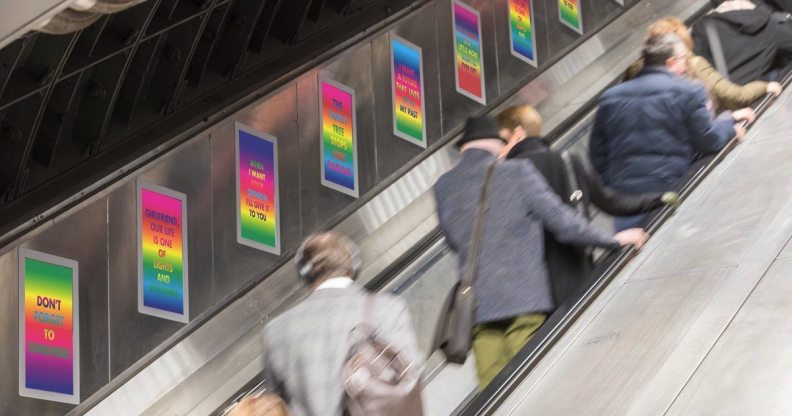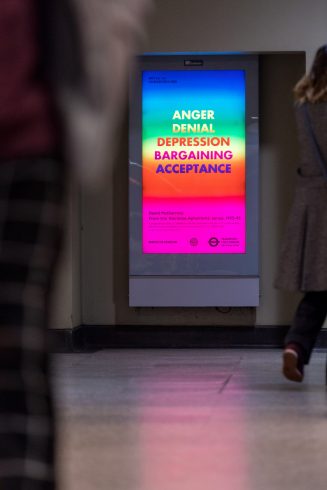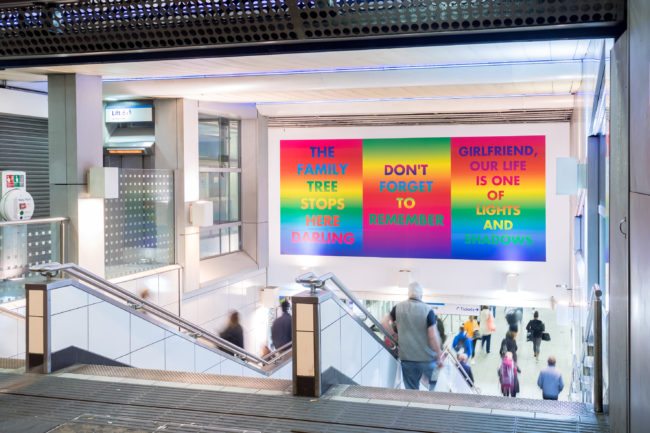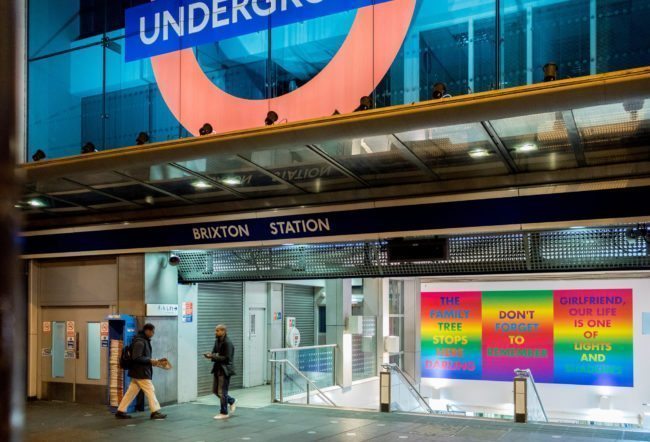This is the reason you keep seeing those rainbow ads on the London Underground

Have you seen these strange rainbow screens on the London Underground recently?
The brightly-coloured rainbow displays have been popping up at stations and on video ad units across the network.

They include cryptic messages like ‘DON’T FORGET TO REMEMBER’ and ‘I WANT A FUTURE THAT LIVES UP TO MY PAST’, in vivid lettering over a rainbow background.
But the video screens often flick away to something else – just as baffled commuters were trying to work out what the ads were actually for.

So, what are they?
Though they appear in advertising units, they’re not actually ads at all.
The work is actually part of Transport for London’s Art on the Underground showcase – and the installation attempts to commemorate those who died in the AIDS crisis.
The project, from the late Australian artist and activist David McDiarmid, was quietly launched late last year.
Titled ‘Rainbow Aphorisms’ (1993-1995), the works feature a series of short and bold statements set on full rainbow backgrounds which reference McDiarmid’s experience of LGBT people during the AIDS crisis.
They were first launched at Brixton Station in November, when signs were installed displaying the phrases ‘THE FAMILY TREE STOPS HERE DARLING, DON’T FORGET TO REMEMBER and GIRLFRIEND OUR LIFE IS ONE OF LIGHTS AND SHADOWS’.
The artworks were later extended to other stations, and to fill spaces on the London Underground’s many ad units.
It is the first major presentation of the artist’s work in the UK.
Speaking about his work in 1992, McDiarmid said, “I wanted to express myself and I wanted to respond to what was going on and I wanted to reach a gay male audience.
“I wanted to express very complex emotions and I didn’t know how to do it … I was in a bit of a dilemma. I thought, well, how can I get across these complex messages.
“I didn’t think it was simply a matter of saying gay is good.”
According to Art on the Underground, over the course of the year artworks from the Rainbow Aphorism series will appear intermittently at various locations.
Eleanor Pinfield, Head of Art on the Underground, said: “Art on the Underground enriches people’s journeys on the Tube each day with innovative approaches to public art.
“By partnering with Studio Voltaire on their first public project, we can bring the complex, colourful works of ‘Rainbow Aphorisms’ to a new audience across London, challenging familiar messaging around HIV/AIDS.”

Justine Simons OBE, Deputy Mayor for Culture & Creative Industries, said: “I’m delighted that David McDiarmid’s colourful, poignant and powerful works will be displayed across London’s largest art gallery – the London Underground.
“McDiarmid was a trailblazing gay activist and the Tube network is the perfect way to showcase his messages about living with HIV/AIDS to a wider audience, particularly in the run up to World Aids Day in December.”
Related: London’s bikes, bus stops and tube stations go rainbow for Pride
There is currently no permanent memorial to those who died in the AIDS crisis in London, despite the impact on the city’s gay community.
The Beacon of Hope in Manchester’s Sackville Gardens is currently the only public memorial in the UK to the thousands who lost their lives during the AIDS crisis.
Earlier this year the devolved London Assembly passed a motion backing the creation of a public AIDS memorial in the city.
Assembly Members agreed a motion calling on Mayor Sadiq Khan to help facilitate plans for the memorial in London.
Labour’s Tom Copley said: “This issue has local, national, and international importance.
“The capital is absolutely the right place for this memorial for both historical and contemporary reasons.
“It was at the heart of the epidemic at the time, is at the cutting edge of medical developments, and today around 40 per cent of those seeking treatment for HIV in the UK do so in London.
“I am delighted the Assembly has backed our call for this memorial, and look forward to seeing the campaign grow and succeed.”
Green Party AM Sian Berry said: “London was at the heart of this country’s AIDS epidemic which affected so many people, their loved ones and their friends. It’s also where some of the most pioneering treatment and prevention methods are being carried out today.
“A dedicated memorial would pay tribute to the people we lost, as well as recognising those living with HIV now.
“It is wonderful that early detection and pioneering treatment allows people in the UK newly diagnosed with HIV to presume a normal life expectancy. However, London is a global city, and Londoners have many family and friends around the world living with HIV and AIDS who face stigma and don’t have access to medication.
“By showing support for a national AIDS memorial here, the Assembly recognises London’s links to all the communities affected, past and present, at home and across the globe.”
The Assembly argues that the memorial would “remember the struggles of those living with HIV as well as those who took on the challenge to treat, support and campaign for those who were affected by AIDS [and] ensure that this period in British history is not forgotten and form a link between the past, the present and the future for all the communities in the UK who bore the brunt of the epidemic”.
Ms Berry had vowed to create a memorial during her failed bid for Mayor of London.
She said: “I’m amazed that London, which bore the brunt of the early AIDS epidemic, still doesn’t have a memorial to the thousands who died.”
Speaking on a visit to to pioneering NHS clinic 56 Dean Street, she said: “It’s now twenty years since life-saving treatments began to transform HIV from a no-hope condition into something much more manageable.
“It’s wonderful that people newly diagnosed with HIV today can expect a normal life expectancy, provided the virus is detected early and they receive treatment.
“That’s why places like 56 Dean Street do such vital work in reaching out to the communities most affected by HIV infection.
“But I’m amazed to hear that London, which bore the brunt of the Aids epidemic in those terrible early days, still doesn’t have a memorial to those thousands who died here.
“Brighton and Manchester have AIDS memorials, as do countless cities around the world, so why not London?”
She added: “As new infections remain high, especially among young gay and bisexual men in London, a lasting memorial – either a physical monument, something more interactive, or a living space – would be a valuable tool for health educators as well as fitting way of remembering those who died.”

